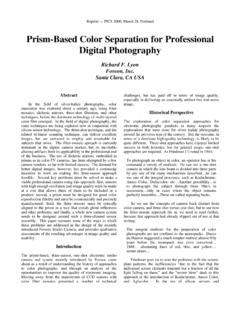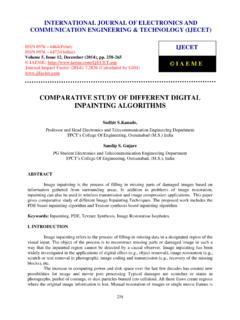Transcription of Optical Image Stabilization (OIS) - st.com
1 1 Optical Image Stabilization (OIS) Fabrizio La Rosa, Maria Celvisia Virz , Filippo Bonaccorso, Marco Branciforte. STMicroelectronics 1. introduction For more than a decade, Image Stabilization (IS) technology has been considered essential to delivering improved Image quality in professional cameras. More recently, as a result of advancing technology, IS has become increasingly popular to handheld device makers who want to propose high-end features for their products. So, manufacturers like ST have worked hard on its technologies and methods for Image Stabilization to significantly improve camera shutter speed and to offer precise suppression of camera vibration.
2 Today, from the technologic point of view, Digital Image Stabilization (DIS), Electronics Image Stabilization (EIS) and Optical Image Stabilization (OIS) are the best understood and the easiest to integrate in digital still cameras and smartphones, though they can produce different Image -quality results: in fact, DIS and EIS require large memory and computational resources on the hosting devices, while OIS acts directly on the lens position itself and minimizes memory and computation demands on from the host.
3 As an electro-mechanical method, lens Stabilization ( Optical unit) is the most effective method for removing blurring effects from involuntary hand motion or shaking of the camera. This paper hosts a technical explanation on the main aspects of Optical Image Stabilization and the actuator technologies and the solutions commonly available in the market. A brief description of the system solution will highlight the main parts and relative considerations on how to design the control algorithm to move the lens precisely.
4 Finally, the last paragraph will also take into account the results obtained from tests carried out on a commercial camera retrofitted with OIS, to verify the performance evaluation method. 2. The spread of OIS in the market of recent years Early on Image Stabilization was an unusual feature in traditional professional cameras and it became more common with the arrival of digital still camera (DSC) on the market. These devices have taken over the digital imaging system market and contributed to drive technological innovation in photography.
5 Then, in 2010, the mobile revolution started and the use of smartphones exploded. The technological evolution encouraged the major phone makers to propose innovative solutions in hardware design that allowed the integration of miniaturized photographic modules in mobile phones to take pictures with camera-like resolution. This revolution has led to the decline of compact DSCs (Figure 1), deposed by camera-equipped phones (Figure 2). Image Stabilization was a key feature, joining display dimension, Near Field Communication (NFC), the Wireless Optical Image Stabilization (OIS) White Paper 2 Charging and Finger print security options, in contributing to the success of smartphones and enabling the segmentation of high-end models to low cost ones.
6 From a marketing perspective, according to an IC Insights report [1], sales of stand-alone digital cameras are projected to decline at an annual average rate of in the forecast period 2012-2017, while revenues for cellphone-camera integrated circuits are expected to rise by an annual rate of in the same period. Figure 1 : Rise and Fall of Digital Still Cameras - Source: IC Insights. Figure 2 : Break-out of camera-IC sales by type of camera application. Optical Image Stabilization (OIS) White Paper 3 (a) As a result of the introduction of these and other innovations, the smartphone market has seen remarkable growth and it is estimated that shipments will exceed 1 billion units in 2014 for the first time.
7 3. OIS: features and benefits The DSC market has moved towards smaller sizes, lower weight and higher resolutions, much as mobile camera modules have followed the same trend after their introduction in smartphones and handsets. A big drawback to this development has been the impact of blurring, caused by involuntary motions, on Image quality. In fact, lighter cameras produce greater blurring. In addition, the introduction of larger LCD displays has encouraged users to take pictures with outstretched arms, further increasing blurring.
8 The introduction of Image Stabilization in several mobile platforms has been a significant added value for photography lovers and especially for younger users, who replaced their traditional and bulky cameras with brand-new smartphones or had cameras available to record memories simply because those cameras were embedded in the mobile platform they were already carrying. Image Stabilization in smartphones enables pictures and video with quality comparable to digital still cameras in so many operating conditions.
9 As a consequence, the request for Image Stabilization is increasing both in compact DSCs and in smartphones. Picture blurring caused by hand jitter, a biological phenomenon occurring at a frequency below 20Hz (see Section ), is even more evident in higher resolution cameras. In fact in smaller resolution cameras the blurring may not exceeds one pixel, which is negligible; but in higher resolution ones it may impact many pixels, thus degrading Image quality significantly (see Figure 3).
10 Optical Image Stabilization technology is an effective solution for minimizing the effects of involuntary camera shake or vibration. It senses the vibration on the hosting system and compensates for these camera movements to reduce hand-jitter effects. So, OIS captures sharp pictures at shutter speeds three, four, or five times slower than otherwise possible. Figure 3 : OIS OFF (a) vs. OIS ON (b) in 5 Mpixel camera. (b) Optical Image Stabilization (OIS) White Paper 4 (b) The increase of the shutter opening time permits more brilliant and clear pictures in indoor or low-light conditions.
















